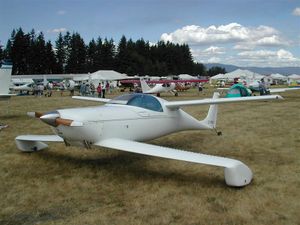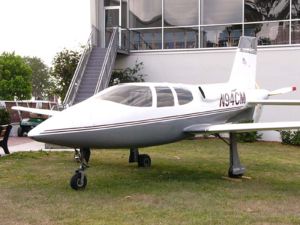PlaneSpottingWorld welcomes all new members! Please gives your ideas at the Terminal.
Homebuilt aircraft
Also known as amateur-built aircraft or kit planes (and classed as "experimental" by the FAA), homebuilt aircraft are constructed by persons for whom this is not a professional activity. These aircraft may be constructed from "scratch," from plans, or from assembly kits. The safety record of homebuilts is comparable to certified general aviation aircraft.
Contents
Overview
In the United States, Australia and New Zealand, homebuilt aircraft may be licensed Experimental under FAA or similar local regulations. Provided that the owner has done at least 51% of the construction work themselves they can also apply for a repairman's certificate for that airframe. The repairman's certificate allows the holder to perform and sign off on most of the maintenance, repairs, and inspections themselves.
The first aircraft to be offered for sale as plans, rather than a completed airframe, was the Baby Ace in the late 1920s.
Homebuilt aircraft gained in popularity in the US in the 1950s with the formation of the Experimental Aircraft Association and with a large demand for light aircraft created by ex-military pilots after World War II.
Homebuilt aircraft are generally small, one to four-seat sportsplanes which employ simple methods of construction. Fabric-covered wood or metal frames and plywood are common in the aircraft structure, but increasingly, fiberglass and other composites as well as full aluminum construction techniques are being used. Engines are most often either the same as or similar to the engines used in general aviation (such as Lycoming, Continental, Rotax, and Jabiru). A minority of homebuilts use converted automobile engines, with Volkswagen air-cooled flat-4s, Subaru-based liquid-cooled engines, Mazda Wankel and Chevrolet Corvair six-cylinder engines being common. The use of automotive engines helps to reduce costs, but many builders prefer dedicated aircraft engines, which are perceived to have better performance and reliability. Other engines that have been used include chainsaw and motorcycle engines.
A combination of cost and litigation, which has discouraged general aviation manufacturers from introducing new designs, has led to homebuilts outselling factory types by five to one. In 2003, the number of homebuilts produced in the USA exceeded the number produced by any single certified manufacturer.
History
The history of amateur-built aircraft can be traced to the beginning of aviation. Even if the Wright brothers, Clément Ader, and their successors had commercial objectives in mind, the first aircraft were constructed by passionate enthusiasts whose goal was to fly.
Early years
Aviation took a leap forward with the industrialization that accompanied the First World War. In the post-war period, manufacturers needed to find new markets and introduced models designed for tourism. However, these machines were affordable only by the very rich.
Many U.S. aircraft designed and registered in the 1920s onward were considered "experimental" by the (then) CAA, the same registration under which modern homebuilts are issued Special Airworthiness Certificates. Many of these were prototypes, but designs such as Bernard Pietenpol's first 1923 design were some of the first homebuilt aircraft. In 1928, Henri Mignet published plans for his HM-8, as did Pietenpol for his Air Camper. Pietenpol later constructed a factory, and in 1933 began creating and selling partially-constructed aircraft kits.
In 1936, an association of amateur aviation enthusiasts was created in France. Many types of amateur aircraft began to make an appearance, and in 1938 legislation was amended to provide for a Certificat de navigabilité restreint d'aéronef (CNRA, "restricted operating certificate for aircraft"). 1946 saw the birth of the Ultralight Aircraft Association which in 1952 became the Popular Flying Association in the United Kingdom, followed in 1953 by the Experimental Aircraft Association in the United States and the Sport Aircraft Association in Australia.
Technology and innovation
Until the late 1950s, builders had mainly kept to wood-and-cloth and steel tube-and-cloth design. Without the regulatory restrictions faced by production aircraft manufacturers, homebuilders showed introduced innovative designs and construction techniques. Burt Rutan introduced the canard design to the homebuilding world and pioneered the use of composite construction. Metal construction in kitplanes was taken to a new level by Richard VanGrunsven in his RV series. As the sophistication of the kits improved, components such as autopilots and more advanced navigation instruments became common.
Litigation during the 1970s and 1980s caused stagnation in the small aircraft market, forcing the surviving companies to retain older, proven designs. In recent years, the less restrictive regulations for homebuilts allowed a number of manufacturers to develop new and innovative designs; many can outperform certified production aircraft in their class.
An example of high-end homebuilt design is Lancair, which has developed a number of high-performance kits. The most powerful is the Lancair Propjet, a four-place kit with cabin pressurization and a turboprop engine, cruising at Template:Convert and 370 knots (425 mph, 685 km/h). Although aircraft such as this are considered "home-built" for legal reasons, they are typically built in the factory with the assistance of the buyer. This allows the company which sells the kit to avoid the long and expensive process of certification, because they remain owner-built according to the regulations.
A small number of jet kitplanes have been built since the 1970s, including the tiny Bede Aircraft BD-5J.
Building materials
Homebuilt aircraft can be constructed out of any material, provided it is light and strong enough for flight. Several common construction methods are detailed below.
Wood and cloth
This is the oldest construction, seen in the first aircraft and hence the best known. For that reason, amateur-built aircraft associations will have more specialists for this type of craft than other kinds.
The most commonly-used woods are Sitka spruce and Douglas fir, which offer excellent strength-to-weight ratios. Wooden structural members are joined with adhesive, usually epoxy. Unlike the wood construction techniques used in other applications, virtually all wooden joints in aircraft are simple butt joints, with plywood gussets. Joints are designed to be stronger than the members.
After the structure has been completed, the aircraft is covered in fabric (usually aircraft-grade polyester).
The advantage of this type of construction is that it does not require complex tools and equipment, but commonplace items such as saw, planer, file, sandpaper, and clamps.
Amateur-built wood/cloth designs include:
- The classic Pietenpol Air Camper, a homebuilt that has been built since the 1920s.
- The Bowers Fly Baby, a low-wing monoplane which has been popular since the 1960s.
- Fisher Flying Products (built with geodetic cross-bracing).
- The Ison miniMAX
- the Jodel models, including the bébé D-9, D-112, and the more recent D-18, D-19, and D-20
- the Piel CP-30 Émeraude
- the VP-1 and VP-2, designed by Bud Evans in the late 1960s and commonly called Volksplanes
A recent trend is toward wood-composite aircraft. The basic material is still wood, but it is combined with foam and other synthetic materials. An example of a wood-composite design is this IBIS experimental aircraft project, designed by Roger Junqua, and the KR series of homebuilts designed by Ken Rand.
Metal
Planes built from metal use similar techniques to more conventional factory-built aircraft. They can be more challenging to build, requiring metal-cutting, metal-shaping, and riveting. A component assembly kit has the material needed to build part of the aircraft, such as the fuselage. Such kits are also available for the other types of aircraft construction.
There are three main types of metal construction: sheet aluminum, tube aluminum, and welded steel tube. The tube structures are covered in fabric, much like wooden aircraft.
Examples of metal-based amateur aircraft include:
- The Murphy Aircraft SR3500 Moose, Rebel and Super Rebel, Maverick, Elite, JDM-8, and Yukon. Murphy Aircraft is a Canadian manufacturer that offers a complete line of aircraft construction kits for home/self construction.
- The RV-4, RV-8, RV-10 and other models produced by Van's Aircraft, are by far the most popular metal homebuilt aircraft. Vans is a U.S. manufacturer whose designs are available in kit form.
- Chris Heintz's Zenith Aircraft Company
- Jean Pottier's Pottier P-230 Panda
- Sonex, Waiex, and Xenos kit planes and plans from Sonex Aircraft
Composite


Composite material structures are made of cloth with a high tensile strength (usually fiberglass or carbon fiber, or occasionally Kevlar) combined with a structural plastic (usually epoxy, although vinylester is used in some aircraft). The fabric is saturated with the structural plastic in a liquid form; when the plastic cures and hardens, the part will hold its shape while possessing the strength characteristics of the fabric.
The two primary types of composite planes are molded composite, where major structures like wing skins and fuselage halves are prepared and cured in molds, and moldless, where shapes are carved out of foam and then covered with fiberglass or carbon fiber.
The advantages of this type of construction include smooth surfaces (without the drag of rivets), the ability to do virtually any compound curve, and the ability to place fiberglass or carbon fiber in optimal positions, orientations, and quantities. Drawbacks include the need to work with chemical products as well as low strength in material directions perpendicular to fiber. Composites provide superb strength to weight. Material stiffness dependent upon direction (as opposed to equal in all directions, as with metals) allows for advanced "elastic tailoring" of composite parts.
Examples of amateur craft made of composite materials include:
- Canard designs such as the VariEze and LongEZ designed by Burt Rutan.
- The Jabiru range.
- all Lancair designs
- the pusher propeller Cirrus VK-30.
See also
External links
- Experimental Aircraft Association (EAA),
- Popular Flying Association, the representative body in the United Kingdom for amateur aircraft.
Lists relating to aviation | |
|---|---|
| General | Timeline of aviation · Aircraft · Aircraft manufacturers · Aircraft engines · Aircraft engine manufacturers · Airports · Airlines |
| Military | Air forces · Aircraft weapons · Missiles · Unmanned aerial vehicles (UAVs) · Experimental aircraft |
| Notable incidents and accidents | Military aviation · Airliners · General aviation · Famous aviation-related deaths |
| Records | Flight airspeed record · Flight distance record · Flight altitude record · Flight endurance record · Most produced aircraft |
fr:Construction amateur d'avion
| This article is licensed under the GNU Free Documentation License. It uses material from the Wikipedia article "Homebuilt aircraft". |

